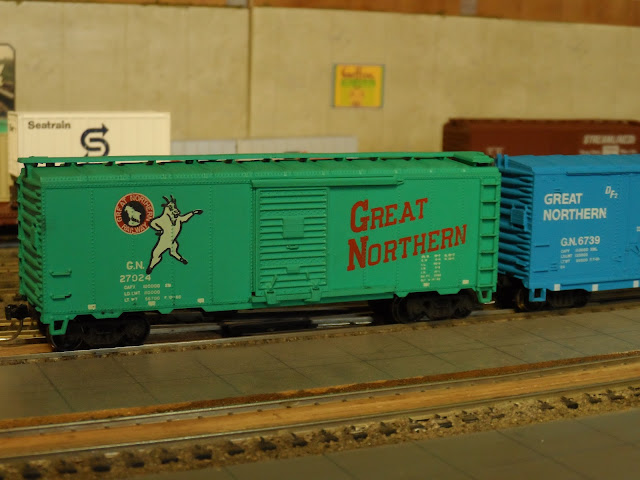Greetings All,
I recently stopped at an Antique Mall in Buford, GA that has a Lindy's Trains booth which is a Trainz.com enterprise. I was looking for a 40' boxcar that I could convert into a track cleaning car to fulfill a track cleaning car request from Sir Neal for his Atlantic Pacific RR..
The GN 6739 is coupled up to a pair of similar NP boxcars to create a three car block.In addition to the target 40' boxcar I came across two Great Northern 40' boxcars in two different paint paint schemes and one Grand Trunk Western 40' boxcar that I decided I couldn't do without. The three built up boxcars each have Kadee couplers and metal wheelsets.
Perfect for the track cleaning car project was this unbuilt and still new in the box GN 40' boxcar 11374 that was chosen to become the track cleaning car that will be be forwarded to the APRR.
The track cleaning pad, made of hardboard also known as Masonite, with two finish nails is easily removed for cleaning and is easy to install.
A couple days later GN 11374 is pulled out of the shop after being modified with a track cleaning pad and upgraded to meet NYCTL and APRR rolling stock standards.
Kadee #37 underset shank couplers were installed to meet the Kadee coupler height gauge without raising the car height. Proto 2000 metal wheelsets (APRR preferred wheelsets) and additional weight were also added.
The track cleaning car and pad was tested extensively around the layout and you can see it picked up some black gunk along the way. This will be cleaned using a toothbrush and Isopropyl alcohol prior to shipment. The track cleaning pad, made of hardboard also known as Masonite, with two finish nails is easily removed for cleaning and is easy to install.
On Friday the GN track cleaning boxcar arrived at The Atlantic Pacific Rock Ridge Yard and was immediately put to work behind leased EBRR GP38 #8163. See link below to catch train X8163 in action on the APRR.
Photo by Sir Neal. Used with permissionPutting the Other Cars in Play
The other three cars cycled thru the NYCTL shops getting cleaned and receiving the standard spray of Testor's Dullcote, rattle can painting of weights, underframe, trucks, additional weight and the correct wheels and couplers.All three of the boxcars came with Kadee #5 couplers and rib backed metal wheelsets. The #5 couplers were swapped in favor of #37 underset shank couplers. The rib backed wheelsets were swapped with plain back wheelsets from some ice bunker reefers.
GTW 40' boxcar 516158 is now ready for revenue service.
GN double door boxcar 6739 features a small grain loading door on the upper right of the right hand door and damage free hardware as indicated by the DF on the left. This car is painted in the "Big Sky Blue" paint scheme introduced in 1967 and used up the 1970 merger into the Burlington Northern.
GN double door boxcar 6739 features a small grain loading door on the upper right of the right hand door and damage free hardware as indicated by the DF on the left. This car is painted in the "Big Sky Blue" paint scheme introduced in 1967 and used up the 1970 merger into the Burlington Northern.
GN boxcar 27024 is a standard sliding door car in the GN Glacier Green paint and lettering scheme introduced in 1961 and used until 1967.
Getting the Newly Added Boxcars
into Revenue Service
I prepared the car cards and waybills so that the newly added boxcars can be blocked with some cars in the existing fleet so they can be run in blocks or as a single car.
With the car cards and waybills complete I set up an inbound train of mostly pre BN predecessor roads like the Spokane Portland & Seattle Railway 50' boxcar to be used in a pre PCCM 111 op session.
Grand Trunk Western 40' boxcar 516158 is paired up with a similar CN 40' boxcar. The GTW became part of the Canadian government owned Canadian National in 1923.
Penn Central F7A-F7B-GP-7 with a Great Northern GP7 painted in Pullman Green and Omaha Orange dubbed the "Simplified Scheme" that was introduced in 1962 power the boxcar laden train designated as Train TY-24 thru Empire City.
Catch Train TY-24 roll thru Empire City and Bedford as it makes its way to Terminal Yard.
Final Thoughts and Comments
I was happy to be of service and help the APRR to keep their tracks clean and earn revenue. Similar track cleaning cars have been in service on my layout for over a decade now and they work great.
The new GN and GTW boxcars have fit right in with the other BN and predecessor road freight cars. I like having the three car blocks of similar cars from similar destinations. The blocked cars can also move individually from place to place if I'm so inclined.
Look for the freight cars from Train TY-24 in the upcoming PCCM 111.
Additional Links and Reading
Great Northern Paint Schemes Thru The Years
Grand Trunk Western Railroad History
Atlantic Pacific Railroad Train X8163


































































